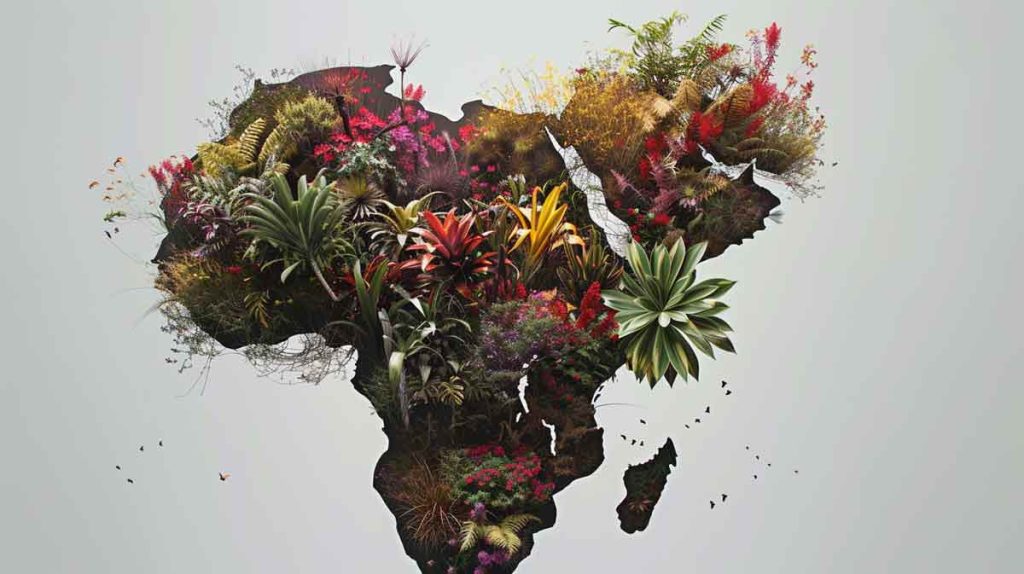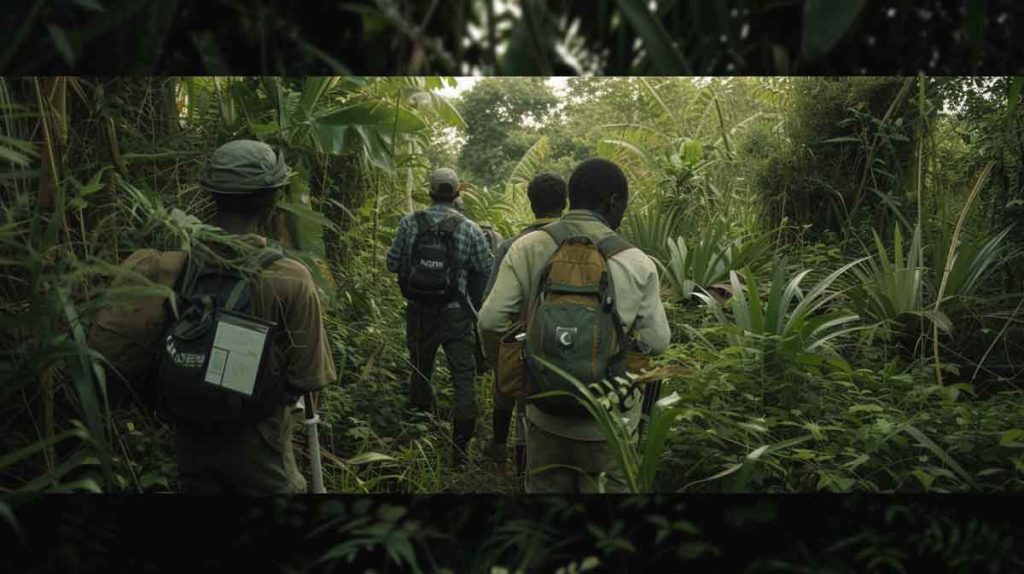Did you know that Africa is home to a staggering botanical diversity, with over 22,000 species of plants?

Understanding the patterns of biodiversity distribution is crucial for the conservation and sustainable utilisation of Africa’s rich botanical diversity. Tropical Africa, in particular, is a treasure trove of plant species, but our knowledge about their distribution and diversity is still limited.
One of the largest databases of tropical African vascular plant species, RAINBIO, provides valuable insights into the diversity of plant and growth forms across tropical Africa. The dataset contains over 600,000 georeferenced records representing more than 22,000 species. However, despite the extensive data collection, tropical Africa remains poorly sampled, with only a few countries being adequately explored. Forests in the region are especially rich in plant species, with high levels of endemism.
Key Takeaways
- Africa is home to over 22,000 species of plants.
- Tropical Africa is particularly rich in botanical diversity.
- The RAINBIO database provides valuable insights into plant diversity in the region.
- Despite significant data collection, tropical Africa remains poorly sampled.
- Forests in the region are particularly rich in plant species and endemic diversity.
Distribution Patterns of Plant Species in Tropical Africa
The distribution of plant species in tropical Africa exhibits significant spatial variations and is influenced by the continent’s diverse geographical features. Understanding these patterns is crucial for studying African botanical geography and conserving regional plant diversity.
The Sahara is a vast desert with arid conditions and scarce vegetation at the northern extreme of tropical Africa. The central Sahara region has very low plant species diversity due to its harsh climate and limited water availability. Conversely, at the southern tip of the continent, Cape Town is one of the most species-rich areas globally, hosting a quarter of all African plant species.
The rich plant diversity in the Cape region can be attributed to its Mediterranean climate and unique ecological conditions. Other regions in tropical Africa also showcase high species richness, such as the West African coast and the Cameroun-Gabon area. These areas benefit from favourable environmental factors and provide suitable habitats for diverse plant communities.
The continent has been divided into distinct floral regions better to understand the distribution patterns of plant species in Africa. Each region has its own evolutionary history and characteristic flora, contributing to African botanical geography. The floral regions in Africa include:
- The Sahara region: A vast desert with low species diversity.
- The Sudanian region: Located south of the Sahara, characterised by savannah and woodland vegetation.
- The Congolese region: Encompassing the Congo Basin, known for its dense rainforests and high species endemism.
- The Horn of Africa region comprises countries such as Ethiopia, Eritrea, Djibouti, and Somalia, featuring unique plant communities adapted to the region’s arid and mountainous landscapes.
- The Zambesian region Covers parts of southern Africa, including Zambia, Zimbabwe, and Mozambique. Miombo woodlands and floodplains characterise it.
- The Southern African region encompasses countries such as South Africa, Botswana, and Namibia, known for their diverse flora, including fynbos, succulents, and grasslands.
These botanical regions offer insights into the geographical patterns of plant diversity and the distinct ecosystems within tropical Africa. By studying and preserving these floral regions, we can ensure the long-term survival of Africa’s unique and invaluable plant species.
The Need for Further Botanical Exploration and Conservation Efforts
Despite the substantial progress in botanical exploration and the availability of large-scale databases, exploring tropical Africa’s flora is far from complete. More intensive inventories and digitisation efforts are needed to fill the knowledge gaps and improve our understanding of the region’s unique flora.

Priority target areas for future sampling efforts have been identified, focusing on Tanzania, Atlantic Central Africa, and West Africa. Expanding the sampling density in these areas is crucial to obtaining a more comprehensive picture of plant diversity. By conducting extensive botanical exploration in these regions, researchers can gather valuable data that will contribute to our understanding of plant distribution and aid in biodiversity management.
Furthermore, recent discoveries of new tree species in African forests highlight many undocumented plant species. This further emphasises the importance of future sampling efforts to uncover Africa’s hidden botanical treasures. The data collected through these exploration and research efforts will enrich our knowledge and provide a solid basis for the sustainable management and conservation of Africa’s plant biodiversity.
These ongoing and future endeavours align with the Global Strategy for Plant Conservation 2011-2020, emphasising the need for botanic gardens, research institutions, and other stakeholders to safeguard plant diversity. By supporting botanical exploration, plant conservation initiatives, and biodiversity management in Africa, we can ensure the long-term preservation of this invaluable natural heritage.
FAQ
What is an African plant?
An African plant is indigenous to or predominantly found on the African continent. This group includes varieties from various genera, such as aloe vera, Euphorbia, and Pelargonium.
What are some commonly known African plants?
Some commonly known African plants include aloe vera, known for its medicinal uses; the South African Geranium and the African Lily, both popular flowering plants; and the Baobab tree, native to Madagascar and mainland Africa.
What is unique about South African plants?
South African plants are unique in their high level of local endemic species. These plants are often used in traditional medicine. The South African National Biodiversity Institute in Pretoria is dedicated to the preservation and study of these species.
Can you tell me about Aloe Vera? Is it like an African plant?
Aloe Vera is an African plant known for its healing properties. It’s a succulent plant species from Aloe, indigenous to South Africa. Aloe Vera plants are widely cultivated worldwide and used in the cosmetics, pharmaceutical, and food industries.
What can you tell about the Euphorbia African plant?
Euphorbia is a diverse genus of flowering plants with many African species. It includes the Euphorbia gigas, the African milk tree, the Euphorbia tirucalli, and the pencil cactus. These plants thrive in semi-arid regions of Eastern Africa.
How about the Pelargonium, an African plant?
Pelargonium, often mistaken for Geraniums, is a genus native to Southern Africa. It’s famous for its brightly coloured, abundant flowers. One of the most well-known species is the Pelargonium graveolens, the South African Geranium, often used as a houseplant.
And what can you share about the African Lily?
Also known as the Agapanthus, the African Lily is a common ornamental plant native to southern Africa. It’s known for its large clusters of blue or white flowers. Gardeners love African Lily plants due to their easy care and stunning presence.
Are there any African plants that can be grown indoors?
Yes, many African plants are well-suited to indoor growth. The Snake Plant, or Sansevieria, is one popular houseplant native to West Africa. It’s admired for its low maintenance and air-purifying capabilities. Another is the Dorstenia, a succulent plant species widely grown in pots.
What is the role of African plants in traditional medicine?
African plants play a significant role in traditional medicine across the continent. For example, aloe vera, indigenous to South Africa, is popularly used for its soothing and healing properties. Additionally, African geraniums have been used to treat respiratory ailments, while various species of the Commiphora genus produce resins used for incense and medicinal purposes.
Do African plants face any threats or conservation issues?
Habitat loss, over-harvesting, and climate change often threaten African plants. However, organisations like the South African National Biodiversity Institute and the Missouri Botanical Garden are dedicated to the conservation, research, and education of these precious native resources.
